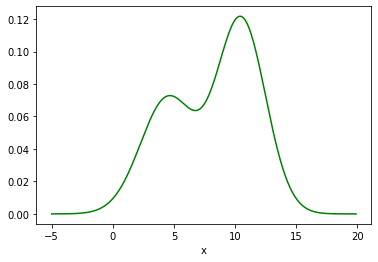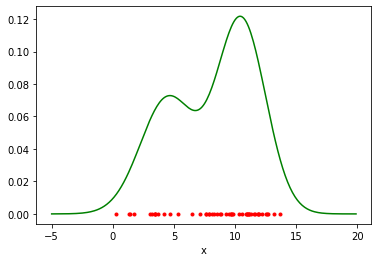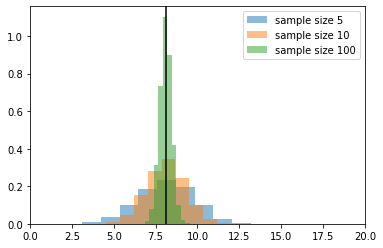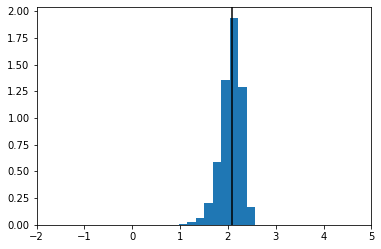Crude MC Estimator
import numpy as np
from matplotlib import pyplot as plt
from scipy.stats import norm
%matplotlib inlineMonte Carlo Integration
mu_1 = 4.5
sigma_square_1 = 5.
sigma_1 = np.sqrt(sigma_square_1)
mu_2 = 10.5
sigma_square_2 = 4.
sigma_2 = np.sqrt(sigma_square_2)
prob_1 = 0.4
size=40rv_1 = norm(loc = mu_1, scale = sigma_1)
rv_2 = norm(loc = mu_2, scale = sigma_2)
x_ = np.arange(-5, 20, .1)
p = lambda x: prob_1 * rv_1.pdf(x) + (1-prob_1) * rv_2.pdf(x)
plt.plot(x_, p(x_) , "g-")
plt.xlabel("x");
Exercise
Write a function which samples from the distribution$ p $.
def sample_from_p(size=size):
raise NotImplementedError()sample = sample_from_p(50)plt.plot(x_, p(x_) , "g-")
plt.plot(sample, np.zeros_like(sample) , "r.")
plt.xlabel("x");
Exercise
What is the (true) expectation$ \mathbb E_{p(x)} [x] $?
Exercise
Implement a crude MC estimator to compute$ \mathbb E_{p(x)} [x] $.
expectation(sample)Variance of the estimation
Now we take different sample sets an show in a histogram which estimations we get.
def get_multiple_estimations(nb_sample_sets= 10000, sample_size=5):
estimated_expectations = []
for i in range(nb_sample_sets):
sample = sample_from_p(sample_size)
e = expectation(sample)
estimated_expectations.append(e)
return np.array(estimated_expectations)
estimated_expectations_5 = get_multiple_estimations()estimated_expectations.mean()estimated_expectations_10 = get_multiple_estimations(sample_size=10)
estimated_expectations_100 = get_multiple_estimations(sample_size=100)plt.hist(estimated_expectations_5, density=True, alpha=0.5, label="sample size 5")
plt.hist(estimated_expectations_10, density=True, alpha=0.5, label="sample size 10")
plt.hist(estimated_expectations_100, density=True, alpha=0.5, label="sample size 100")
plt.axvline(true_expectation, color="k")
plt.legend()
plt.xlim(0, 20);
# estimated variance of the estimators
print (estimated_expectations_5.var(ddof=1))
print (estimated_expectations_10.var(ddof=1))
print (estimated_expectations_100.var(ddof=1))2.6054021109717374
1.282693283187293
0.12742666113328097
TODO: show dependence on 1/sample_size
Example of an Biased Estimator
# for the log of the expectation we have an biased estimator!
# Explain why?
np.log(estimated_expectations).mean()plt.hist(np.log(estimated_expectations), density=True)
plt.axvline(np.log(true_expectation), color="k")
plt.xlim(-2, 5);
np.log(true_expectation)